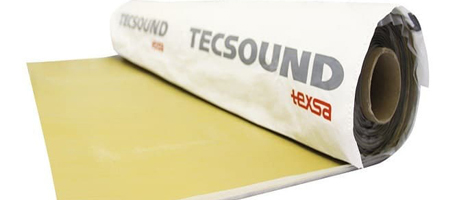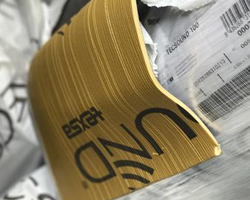Tecsound 100
| Features | Benefits |
| Easier to use, cut and trim. | 100% recyclable. |
| Supplied in roll form. | Unbeatable flexibility even down to -20°C. |
| Airborne and Impact reduction. | Self adhesive version available. |
| Good acoustic performance. | Will also provide a degree of impact reduction. |
| Visco-elastic. |
Tecsound 100
A polymer-based, asphalt-free, high density synthetic soundproofing membrane, that offers good acoustic insulation in different building elements. It has extremely high visco-elasticity as well as being extremely flexible even in cold temperatures.
Tecsound 100 scrim reinforced (T100 Part Code A140)
This material has excellent sound insulating properties. Many construction materials and techniques do not provide enough damping. Rigid sheet materials such as plasterboard absorb little sound energy becuase they tend to vibrate and re-radiate sound on the other side quite effectively. Tecsound acoustic membrane however has tremendous density and mass whilst being extremely 'limp', its acoustically better than lead of the same surface mass, so will help absorb sound energy far more efficiently.
Whilst some systems rely on visco-elastic glues to provide 'damping' the results achieved will vary greatly on the application of the glue. Is it too thick ? is it too thin ? has it been applied evenly and consistantly ?
Visco-elastic glues do not add any extra mass to a system and at the end of the day the best way to reduce bass transmission is by having a heavy weight, heavily damped, mass/spring system. Tecsound Acoustic Membrane provides the best of both worlds, high additional mass and high damping, that can be applied not only over 100% of the area in question but uniformly
Packaging and Storage |
||||
| Product | Weight / m² | Thickness | Rolls size | |
| Tecsound 100 | 10 | 5.2mm | 4 x 1.2m rolls | |
| (PLEASE NOTE): 1m² of material covers approx. 0.9 - 0.95m² allowing for overlaps). *sizes are nominal, ± 2% | ||||
Technical Data |
|||||||
|---|---|---|---|---|---|---|---|
| Test | Value | ||||||
| Density | 1.9g/cm³ (± 0.05) | ||||||
| Pliability (UEAtc) | Does not break when bent at -20°C | ||||||
| Elongation (UNE 104-281/6.6 | 300% | ||||||
| Crushing strength | 4.84kg/cm² | ||||||
| Fire resistance | Euroclass B, s2, d0 (Class0 UK equivalent) | ||||||
| Continuous operating temperature | 70°C (short term 100°C) | ||||||
| Melting point | 140°C | ||||||
| Thermal Conductivity | 0.450 W/mK | ||||||
| Airborne Acoustic performance (7kg/m²) | Rw28dB | ||||||
| Impact Acoustic performance (10kg/m²) under 50mm concrete | ΔLw16dB | ||||||
Applications
- Soundproofing against airborne noise in vertical walls with low surface density (lightweight partition walls or boards made of different materials).
- Soundproofing against airborne noise in ceilings and floors.
- When bonded between stiff rigid sheet materials it greatly reduces the resonance and coincidence dips.
- When stapled over frameworks it greatly improves a lightweight partitions overall performance.
- When bonded to lightweight resonating metal panelwork it greatly reduces vibration and re-radiated noise.
- Damping of impact noise caused by rain on metal deck roofs.
- Combined with sound-absorbent materials, it offers products with high acoustic performance.
- Its applications in the industrial field cover from the soundproofing of booths to the acoustic insulation of machine-rooms, gutter pipes, sound-damping of metal sheets, etc.
Which way round?
The material has a reinforcing scrim facing on one side.
When stapling over a framework you want the scrim side facing you.
When laying on a floor have the scrim side facing you. When using multiple layers you will may find the material will want to tack to itself so keep scrim side against brown side.
When sticking in-between plasterboard stick the brown side to the first board.
Our Products
Key Products
- Noise S.T.O.P. FabrisorbTM
- FabriWall Acoustic Panel
- D'ecopanel Acoustic
- Sound Barrier
- FOAM STOPTM Polyurethane
- FOAM STOPTM SoundWave
- EnviorocousticTM Wood Wool
- Ploy MaxTM Polyester Acoustics
- WoodTEC Acoustic Panels
- AcoustyFABRIC
- Polysorb Acoustics
- AcoustyDOOR
- Duct Sound
- Noise STOPTM Acoustimetal””
- MetalineTM
Featured Products
Product Line
- Absorptive Quilted Curtains
- Acoustical Foam Panels
- Acoustik Underlayment
- Acoustic Windows
- Adjustable Jamb Seals
- Barrier – Decoupler
- Barrier ACT Ceiling Tiles
- Barrier-Backed Ceiling Tiles
- CFAB Cellulose Panels
- Climate Seal Window Inserts
- Cotton Soundwave Eggcrate Panels
- Curve Panels
- dBa Ceiling Ceiling Tiles
- Duracoustic
- Echo Eliminator Baffles
- Exterior Quilted Barrier/Absorbers
- Glasswool Ceiling Tiles
- Green Glue Damping Compound
- Heavy Duty Door Seal Kits
- Magnetic Astragal
- Melamine Composite Panels
- Painted Nubby Fiberglass Tiles
- PVC and Sailcloth Baffles
- Pyramid Diffuser
- Quiet Floor NP
- Quiet Floor Walk
- Quilted Exterior Absorbers
- RSIC-1 Clips
- RSIC-1 Ext04 Clips
- Rubber Isolation Hangers
- Sonex One
- Sound Silencer Baffles
- Sound Silencer™ Ceiling Tiles
- Spring Isolation Hangers
- Spring Isolation Mounts
- Squareline Ceiling Tiles
- Standard Door Seal Kits
- Stud Isolators
- Studio 3D Doors
- Studio Windows
- Super W Pads
- Tecsound Acoustic Membrane
- Ultra Touch Insulation
- Whisper Wave Clouds




